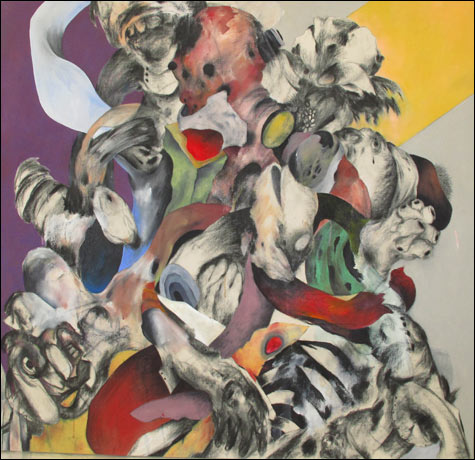
WILD ENERGY Ahmed Alsoudani corrals violence. |
Gravity, of course, is relative. The weight of a thing is meaningless without its pull toward another. This is especially evident at Aucocisco's November exhibition, where multiple thoughtful takes on the theme of gravity bind the works by Gail Spaien and Ahmed Alsoudani.
In Spaien's eight serial watercolors, garlands of flowers — closely resembling daisies — playfully compose patterns and landscapes in untitled 30-by-40-inch frames. With assiduous detail, Spaien has rendered her flowers according to a very personal set of rules. Uniformly, each has 13 petals. Earth-tone hues (blues, yellows, and browns) have been delicately applied, yielding annular stripes, ring-like breaks in coloration that give each flower a vibrant glow. In "Shift #1," a cluster of flowers forms a landscape in the lower half of the frame, lively brown flower heads foreshadowing skeletal blue ones. Mid-frame, the flowers collect into an airy vinous pattern, ascending through the top of the image. In the center of the flower mass, three looms of interwoven florets hover in the foreground, as if propping up the blossom. In "Shift #5," the daisies are disarticulately scattered; this time faint impressions of their florets shadow their bodies.
Daisies are perennial, symbols of a natural, harmonious order, and Spaien has invoked them with palpable energy. Both as discrete pieces and a collective series, her flowers are collected in great, overlapping clusters, buoyant and animated. In another technique, Spaien employs a structural gambit to marvelous effect: her frames are mounted low on the gallery wall, below waist level, lending her work a relationship to heaviness. Though not usually an installation artist, Spaien patterned the walls on her side of the gallery with grids and florets, lending the gallery the stillness of a fossilized arboretum.
Daisies are a keen choice: they are durable, inoffensive flowers with social function (after all, they are the original "he-loves-me, he-loves-me-not" flower). What cannot be ignored, however, is their association with mortality. As Spaien is surely aware, daisies are the most popular floral decorations for grave sites, where they are often found in clusters similar to those seen here. With this lens in mind, Spaien's low-framed arboretum is recast into a sort of spectral mausoleum. The flowers' levity transmits a spiritual tone.
The three charcoal and acrylic paintings by 35-year-old Iraqi refugee Ahmed Alsoudani are explosive, expressionist sites where a multiplicity of forms and figures violently collide. Lately the subject of incredible accolade and attention in contemporary art circles, Alsoudani's tortuous personal narrative is inextricable from his work.
Raised a relatively secularized Shi'a in a predominantly Sunni neighborhood in western Baghdad, Alsoudani fled Iraq at 19 after he was caught painting over a mural of Saddam Hussein. He began painting seriously a year later in Syria. Soon after, he studied painting and English at the Maine College of Art before receiving graduate education at Yale. His success has come with a shadow: Alsoudani has been living in exile and estranged from his family for nearly half his life.